Entry Database : PDB / ID : 6du3Title Structure of Scp1 D96N bound to REST-pS861/4 peptide Carboxy-terminal domain RNA polymerase II polypeptide A small phosphatase 1 REST-pS861 Keywords / / / / / / Function / homology Function Domain/homology Component
/ / / / / / / / / / / / / / / / / / / / / / / / / / / / / / / / / / / / / / / / / / / / / / / / / / / / / / / / / / / / / / / / / / / / / / / / / / / / / / / / / / / / / / / / / / / / / / / / / / / / / Biological species Homo sapiens (human)Method / / / / Resolution : 2.58 Å Authors Burkholder, N.T. / Mayfield, J.E. / Yu, X. / Irani, S. / Arce, D.K. / Jiang, F. / Matthews, W. / Xue, Y. / Zhang, Y.J. Funding support Organization Grant number Country National Institutes of Health/National Institute of General Medical Sciences (NIH/NIGMS) 1R01GM104896-01A1 Robert A. Welch Foundation F-1778
Journal : J. Biol. Chem. / Year : 2018Title : Phosphatase activity of small C-terminal domain phosphatase 1 (SCP1) controls the stability of the key neuronal regulator RE1-silencing transcription factor (REST).Authors : Burkholder, N.T. / Mayfield, J.E. / Yu, X. / Irani, S. / Arce, D.K. / Jiang, F. / Matthews, W.L. / Xue, Y. / Zhang, Y.J. History Deposition Jun 19, 2018 Deposition site / Processing site Revision 1.0 Sep 26, 2018 Provider / Type Revision 1.1 Nov 7, 2018 Group / Database references / Category / citation_authorItem _citation.journal_volume / _citation.page_first ... _citation.journal_volume / _citation.page_first / _citation.page_last / _citation.title / _citation_author.identifier_ORCID / _citation_author.name Revision 1.2 Jan 1, 2020 Group / Category / Item Revision 1.3 Nov 13, 2024 Group Data collection / Database references ... Data collection / Database references / Derived calculations / Structure summary Category chem_comp_atom / chem_comp_bond ... chem_comp_atom / chem_comp_bond / database_2 / pdbx_entry_details / pdbx_modification_feature / pdbx_struct_conn_angle / struct_conn / struct_conn_type Item _database_2.pdbx_DOI / _database_2.pdbx_database_accession ... _database_2.pdbx_DOI / _database_2.pdbx_database_accession / _pdbx_struct_conn_angle.ptnr1_auth_asym_id / _pdbx_struct_conn_angle.ptnr1_auth_comp_id / _pdbx_struct_conn_angle.ptnr1_auth_seq_id / _pdbx_struct_conn_angle.ptnr1_label_asym_id / _pdbx_struct_conn_angle.ptnr1_label_atom_id / _pdbx_struct_conn_angle.ptnr1_label_comp_id / _pdbx_struct_conn_angle.ptnr1_label_seq_id / _pdbx_struct_conn_angle.ptnr3_auth_asym_id / _pdbx_struct_conn_angle.ptnr3_auth_comp_id / _pdbx_struct_conn_angle.ptnr3_auth_seq_id / _pdbx_struct_conn_angle.ptnr3_label_asym_id / _pdbx_struct_conn_angle.ptnr3_label_atom_id / _pdbx_struct_conn_angle.ptnr3_label_comp_id / _pdbx_struct_conn_angle.ptnr3_label_seq_id / _pdbx_struct_conn_angle.value / _struct_conn.conn_type_id / _struct_conn.id / _struct_conn.pdbx_dist_value / _struct_conn.pdbx_leaving_atom_flag / _struct_conn.ptnr1_auth_asym_id / _struct_conn.ptnr1_auth_comp_id / _struct_conn.ptnr1_auth_seq_id / _struct_conn.ptnr1_label_asym_id / _struct_conn.ptnr1_label_atom_id / _struct_conn.ptnr1_label_comp_id / _struct_conn.ptnr1_label_seq_id / _struct_conn.ptnr2_auth_asym_id / _struct_conn.ptnr2_auth_comp_id / _struct_conn.ptnr2_auth_seq_id / _struct_conn.ptnr2_label_asym_id / _struct_conn.ptnr2_label_atom_id / _struct_conn.ptnr2_label_comp_id / _struct_conn.ptnr2_label_seq_id / _struct_conn_type.id
Show all Show less
 Open data
Open data Basic information
Basic information Components
Components Keywords
Keywords Function and homology information
Function and homology information Homo sapiens (human)
Homo sapiens (human) X-RAY DIFFRACTION /
X-RAY DIFFRACTION /  SYNCHROTRON /
SYNCHROTRON /  MOLECULAR REPLACEMENT /
MOLECULAR REPLACEMENT /  molecular replacement / Resolution: 2.58 Å
molecular replacement / Resolution: 2.58 Å  Authors
Authors United States, 2items
United States, 2items  Citation
Citation Journal: J. Biol. Chem. / Year: 2018
Journal: J. Biol. Chem. / Year: 2018 Structure visualization
Structure visualization Molmil
Molmil Jmol/JSmol
Jmol/JSmol Downloads & links
Downloads & links Download
Download 6du3.cif.gz
6du3.cif.gz PDBx/mmCIF format
PDBx/mmCIF format pdb6du3.ent.gz
pdb6du3.ent.gz PDB format
PDB format 6du3.json.gz
6du3.json.gz PDBx/mmJSON format
PDBx/mmJSON format Other downloads
Other downloads 6du3_validation.pdf.gz
6du3_validation.pdf.gz wwPDB validaton report
wwPDB validaton report 6du3_full_validation.pdf.gz
6du3_full_validation.pdf.gz 6du3_validation.xml.gz
6du3_validation.xml.gz 6du3_validation.cif.gz
6du3_validation.cif.gz https://data.pdbj.org/pub/pdb/validation_reports/du/6du3
https://data.pdbj.org/pub/pdb/validation_reports/du/6du3 ftp://data.pdbj.org/pub/pdb/validation_reports/du/6du3
ftp://data.pdbj.org/pub/pdb/validation_reports/du/6du3 Links
Links Assembly
Assembly


 Components
Components Homo sapiens (human) / Gene: CTDSP1, NIF3, NLIIF, SCP1 / Production host:
Homo sapiens (human) / Gene: CTDSP1, NIF3, NLIIF, SCP1 / Production host: 
 Homo sapiens (human) / References: UniProt: Q13127*PLUS
Homo sapiens (human) / References: UniProt: Q13127*PLUS X-RAY DIFFRACTION / Number of used crystals: 1
X-RAY DIFFRACTION / Number of used crystals: 1  Sample preparation
Sample preparation SYNCHROTRON / Site:
SYNCHROTRON / Site:  APS
APS  / Beamline: 23-ID-D / Wavelength: 0.97648 Å
/ Beamline: 23-ID-D / Wavelength: 0.97648 Å molecular replacement
molecular replacement Processing
Processing MOLECULAR REPLACEMENT / Resolution: 2.58→39.2 Å / Cross valid method: THROUGHOUT /
MOLECULAR REPLACEMENT / Resolution: 2.58→39.2 Å / Cross valid method: THROUGHOUT /  Movie
Movie Controller
Controller



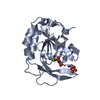

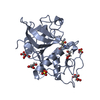
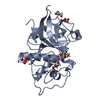

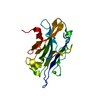
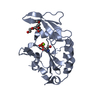


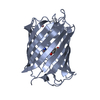
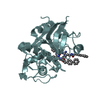
 PDBj
PDBj










